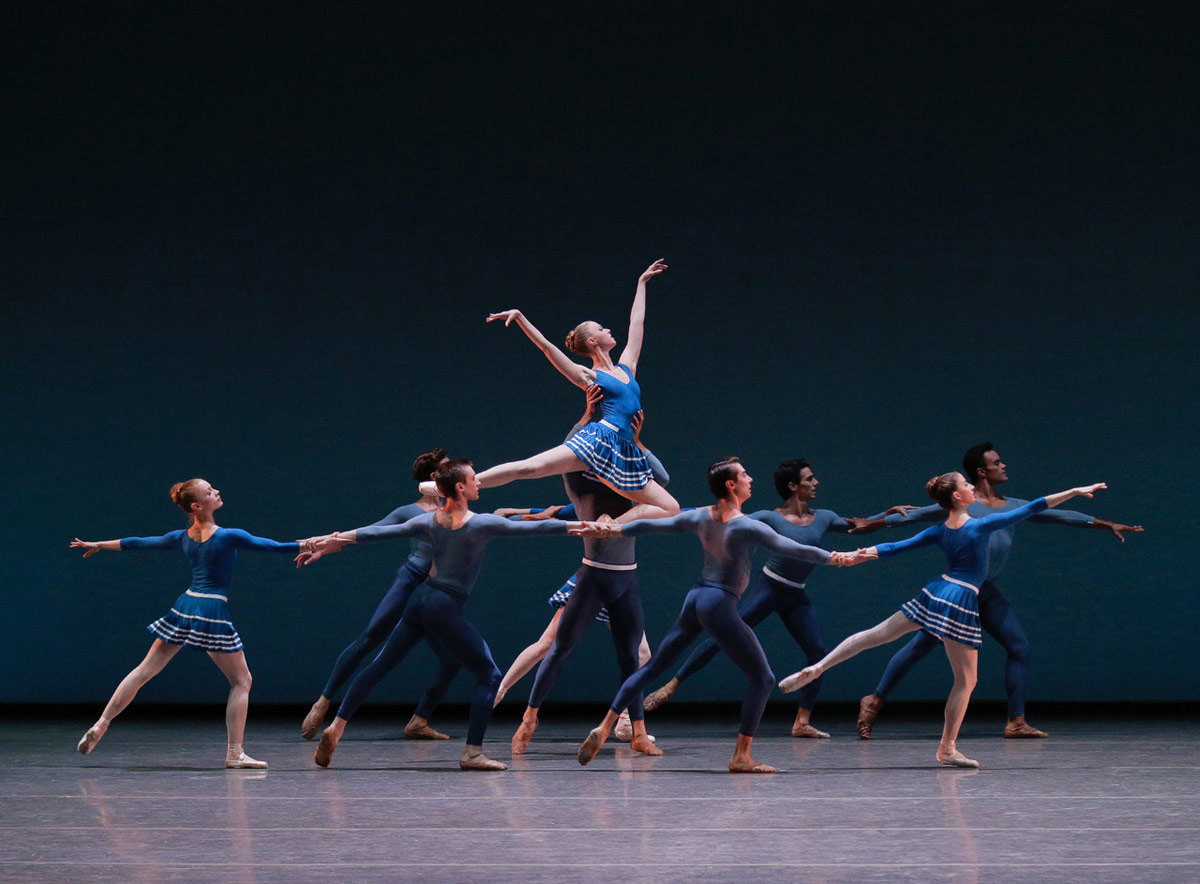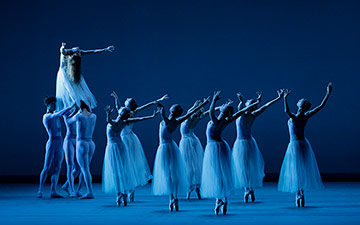
© NYCB. (Click image for larger version)
New York City Ballet
10 May: HERE/NOW No. 6: Carousel (A Dance), The Blue of Distance, The Infernal Machine
12 May: HERE/NOW No. 8: Chiaroscuro, Slice to Sharp, Stabat Mater, The Decalogue, Pictures at an Exhibition, Year of the Rabbit
★★★✰✰
New York, David H. Koch Theater
10, 12 May 2017
www.nycballet.com
davidhkochtheater.com
Justin Peck Grows Up
I’ve been wondering lately whether Justin Peck is in a bit of a rut, producing brilliant, intricate piece after brilliant, intricate piece, but somehow keeping the best of himself locked away. A certain sterility was creeping into his work. But I needn’t have worried; with his latest, The Decalogue, which opened on May 12, he seems to have turned a new page. Maybe, even, relaxed just a little, and allowed himself the luxury of expressing something very pure, a meditation on his company and of the ethics upon which ballet is built.
The first thing one notices about The Decalogue is its stillness, not a quality I would ever have associated with Peck before today. The ballet begins, like many works by George Balanchine, with the dancers standing, still, facing forward, with their feet in a parallel position, not turned out. The choreography often pauses, for a moment, as if to breathe, the better to linger in our collective memory. This is not the only Balanchinean aspect of the work. There are the costumes: elegant leotards and unitards in shades of gray, flattering to the body and designed by Peck himself. There is the golden light, by Jennifer Tipton, which makes the dancers look like heavenly beings. In this spacious landscape, a magnificent civility rules, reigned over by a ballerina of authority and wit, Sara Mearns.
The score, by the alt/folk/rock/electronica songwriter Sufjan Stevens – what do these labels even mean? – is equally spare, a ten-part suite for solo piano, sensitively played by company pianist Susan Walters. I don’t know Stevens’ music well, but on the basis of the pieces he has created for Peck in ballets like Year of the Rabbit and Everywhere We Go, this score seems like a departure. Clean, simple, meditative, dominated by descending patterns, it organizes the movement and suffuses it with subtle colors. Unlike the music of the Minimalist composers – much used in ballet – it is neither manipulative nor obsessively repetitive. It feels somehow closer to Debussy than to Steve Reich.

© NYCB. (Click image for larger version)
In this ballet, Peck seems bent on tackling the one area of his imagination that until now has yielded the least satisfaction: partnering. He does this both in the pas de deux and in larger groupings of three or four dancers. The Decalogue is full of duets, momentary or extended, including several beautiful passages for Sara Mearns and her frequent partner Jared Angle. Peck capitalizes on the familiarity between these two dancers, the friendship and respect that exists between them, creating partnering that feels both amicable and civilized, more like a conversation between friends than the projection of an ideal or of an invented emotional state. (In this he is very different from Balanchine.) They are not “man” and “woman,” but Sara and Jared, exploring, reaching, leading, conversing, supporting. Nothing is spectacular, except for a moment in which Angle expertly lifts and spins Mearns in his arms. But the moment passes without comment; it is just one further demonstration of the two dancers’ infinite skill, of their ability to work together as wondrously capable comrades.
It wouldn’t be a Peck ballet if there weren’t surprising and beautiful patterns to admire. Three women partner Gonzalo García, forming a many-pointed star. A cluster of dancers opens out into a pleasing geometric shape. In a line of dancers, each gently pushes the person in front of him/her, creating a wave. Two dancers pass their arms over a human chain, and as they do, the links break free and scatter across the stage. There is much to marvel at, but the feeling here is less showy, more focused and low-key than in other Peck ballets. What emerges is a portrait of a company, in which each dancer has a key role to play, a personality, a place.

© Paul Kolnik. (Click image for larger version)
A few days earlier, the company performed Peck’s very first big work, from 2012, Year of the Rabbit. It was obvious, seeing it again, why the world immediately took notice of this young choreographer. I had forgotten how many pas de deux it, too, contained, exhibiting some of the qualities one sees in The Decalogue. It’s almost as if, after Rabbit, Peck had felt that the male-female duet was somehow too regressive, too classical, to really explore wholeheartedly. I’m glad he’s changed his mind. This early work is much more virtuosic and idea-packed than The Decalogue. It wants very much to impress, and it does. A million ideas flicker through the choreography: Legs, used as turnstiles; a pile of heads à la Les Noces; bodies flung across the stage, sliding like kids on a carnival ride. The dancing is fast and furious, full of details, quick changes of tempo and texture – sharp and round, soft and hard, bodies expanding and contracting. What Peck hadn’t quite figured out at the tender age of 25 was how to make it all cohere.
Both of these programs were too long; this has been a problem throughout the Here/Now festival. By the time the main attraction arrives, you’re already exhausted. The May 10 performance of Year of the Rabbit was preceded by: Christopher Wheeldon’s Carousel (A Dance), Robert Binet’s The Blue of Distance, Peter Martins’ The Infernal Machine, and Alexei Ratmnasky’s Pictures at an Exhibition. The performance of Pictures was memorable; it is impressive how each new cast-member makes this ballet his or her own and finds new colors in its rich imagery. Ashley Laracey, one of the most underused talents in the company, was stylish and vulnerable in the rather aggressive pas de deux The Infernal Machine. (Craig Hall, now a ballet master at the company, had to come out of retirement to partner her, due to the many injuries this season. He looked good.) The Blue of Distance hasn’t deepened much with age, but Harrison Ball, in the central role of the dreamer, danced with intensity and a beautiful elasticity. Carousel, its female lead danced with abandon by Lauren Lovette, was dark and stormy as ever.

© Paul Kolnik. (Click image for larger version)
On the night of the Decalogue premiere, the program also included Chiaroscuro, an atmospheric but slight piece by Lynne Talyor-Corbett set to Geminiani’s orchestration of Corelli’s violin sonata La Follia, a set of variations; Slice to Sharp, by the once ubiquitous Jorma Elo (music by von Biber and Vivaldi), and Peter Martins’ Stabat Mater (Pergolesi). Lots of baroque music for one evening! The orchestra, under the baton of guest conductor Harrison Hollingsworth, acquitted itself well. Hollingsworth is also the ensemble’s principal bassoonist. We mustn’t forget that this marathon festival has also been a marathon for the musicians.
The dancers gave their all, though Slice to Sharp, with its tricky, awkward partnering, looked under-rehearsed and a tad rough. In Stabat Mater, the standout was young corps-member Joseph Gordon; with his juicy jumps, articulate footwork, and generous upper body movement, he suddenly looked like the principal dancer he might one day become.
It was a long night, made altogether worthwhile by The Decalogue, which just might be the mark of a choreographer entering a new phase.

















You must be logged in to post a comment.